Cleaning cesspools: a review of the best methods + eliminating siltation
Even the simplest type of sewage system with a cesspool can significantly increase the level of comfort in a suburban area.However, this solution has a significant disadvantage - the container for the accumulation and primary processing of wastewater requires periodic removal of the contents. Agree, cleaning of cesspools must be carried out according to the rules so that no damage is caused to the environment.
For owners of private houses and summer cottages not connected to centralized sewer networks, we offer scrupulously verified, systematic information about the methods and specifics of cleaning. With our help, you will be able to choose the best option for disposal of wastewater accumulations and learn how to implement it.
A detailed description of the methods used in practice is based on the personal experience of household owners. The requirements of utility standards are taken into account. The information is confirmed by photo and video applications.
The content of the article:
Removing accumulated sewage
Principle of operation cesspool is simple - wastewater flows through a sewer pipe into a container intended for it and accumulates in it. If this is a sealed version of the structure, then it fills up quite quickly.
In case of use cesspool without bottom with an absorption well connected to it, waste removal will not be needed so often, since part of the liquid waste flows through its filter walls and bottom filter, being processed inside the ground.
In any case, these non-aromatic accumulations, which accumulate at the bottom in the form of insoluble sediment, must be periodically disposed of.
Modern summer residents and homeowners have three main ways to do this:
- removal of sewage by pumping;
- use of preparations for biological decomposition of waste;
- chemical cleaning.
When figuring out how to effectively clean a cesspool, you should consider the specifics of using each of these methods. Depending on the situation, only one of them may be needed, but often it is necessary to carry out cleaning activities in combination. For example, after using biological drugs, additional pumping of sewage may be necessary.
When should cleanup activities begin? The work strategy should be thought through at the stage of creating a sewerage system, for example, by providing access roads for a sewer truck.
There is no need to wait until the drains fill the last cubic centimeter of the container. Excessive filling of the cesspool increases the likelihood of contamination of the area several times. If two-thirds of the tank is occupied by wastewater, it is time to reduce its level using available means.
Method #1 - emptying and pumping out the cesspool
If desired, the cesspool can even be cleaned manually, using an ordinary bucket on a rope. Owners of small summer cottages do just that. This work is extremely unpleasant and requires preparation. First, you should wear a protective suit or other clothing that you don’t mind getting dirty. This is necessary in order to protect the skin, the drains can be quite aggressive.
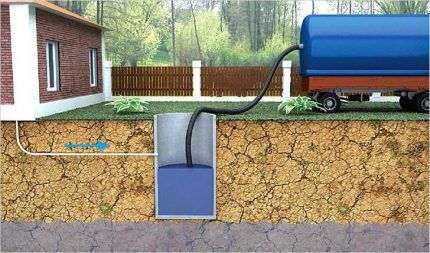
Then you need to take care of protecting the respiratory tract, and it’s not just the characteristic stench. The fumes emanating from the sewer contain methane, the inhalation of which is extremely dangerous for humans. For the same reason, it is not recommended to carry out cleaning work alone, especially if work is planned inside the cesspool.
If the one below becomes unconscious from the toxic fumes, a partner can help him. In addition to a protective suit and respirator, you need to wear high rubber boots or shoe covers, as well as gloves.
You will also need a sealed container into which the contents of the cesspool will be disposed of. Later, this sewage must be taken to the place designated for its disposal.
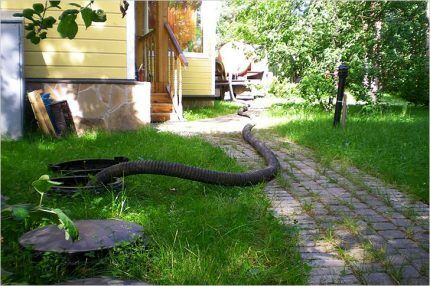
Manual cleaning is a long, dangerous and unpleasant task. If your budget allows, it is better to use a special one for pumping sewage into a container, not a bucket. fecal pump.
Things will go much faster, there will be significantly fewer dangerous contacts with a lot of wastewater. But in this case we must not forget about security measures.
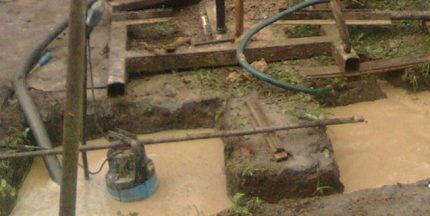
It is much more convenient to clean the cesspool using specialized equipment, for example, a sludge sucker.This is a machine that drives up to the site and pumps out wastewater through a special wide hose.
The distance between the suction pump and the cleaning object should be no more than four meters. This technique does not service pits more than three meters deep, but such deep structures are usually not found.

Even when constructing a pit, you should take into account this nuance: vacuum cleaners charge not for the volume of pumped out waste, but for each visit. In order to reduce costs, it is necessary to calculate the volume of the cesspool so that a quantity of wastewater that is a multiple of the capacity of the suction pump is intended for pumping. At the same time, you need to remember that pumping begins if the pit is two-thirds full, and not “to capacity.”
Method #2 - biological decomposition of wastewater
The process of recycling wastewater with the help of microorganisms is widely used in various septic tanks and industrial VOCs. But today, even for cesspools, a line of biological products has been developed that can do what is not possible when emptying cesspools - reduce or completely eliminate the unpleasant odor characteristic of sewers.
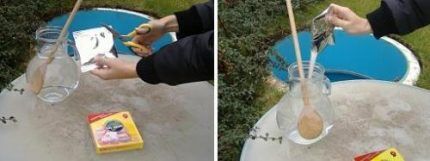
The sewage disposal truck leaves, and a suffocating sewer spirit hovers over the site for several more hours, or even days. The use of biological drugs significantly improves the situation.
To do this, you need to choose a suitable product and use it in accordance with the instructions. Release bacteria for cesspools in the form of gels, liquids, powders, granules, etc.
Microorganisms decompose the contents of the sewer into water and environmentally neutral sludge. From the permeable pit, water flows into the surrounding soil, and silt gradually accumulates. Naturally, the degree of such purification is lower than that of high-tech VOCs; the water cannot be used for irrigation, and the sediment cannot be used as fertilizer. But the speed of filling the cesspool is reduced significantly.
Of course, the sediment from the sewerage structure itself will not go anywhere; it also needs to be removed or pumped out using the method described above using sewer trucks. There is one more important nuance - not all wastewater can be processed using bacteria.
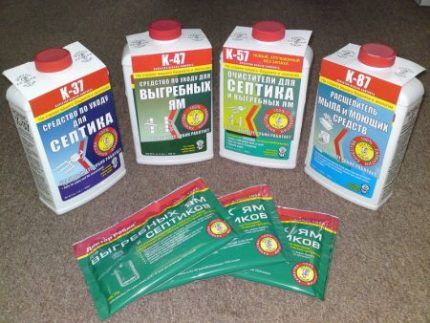
Inorganic waste that enters the sewer accumulates at the bottom and reduces the amount of free space in the storage tank. Aggressive household chemicals, such as those containing chlorine, can create an environment that is harmful to microorganisms. Owners of washing machines and dishwashers should be careful in this regard.
Method #3 - use of chemicals
If biological treatment is just a holiday for the environment, then the use of chemicals can pose a threat.
To remove waste from cesspools, the following are most often used:
- formaldehyde preparations;
- nitrate oxidizers;
- ammonium salts.
Even those who are far from chemistry know that formaldehyde is a dangerous substance. Its only advantage is its relatively low price. This drug is toxic and can cause cancer. For these reasons, formaldehyde is practically not used to clean cesspools.
Cleaners based on nitrate oxidizers have much better safety characteristics. Their composition is close to the components of fertilizers of this type, i.e. If the dosage is correct and the instructions are followed, this cleaner is completely safe. These drugs have a high price, which is fully justified by their high efficiency.
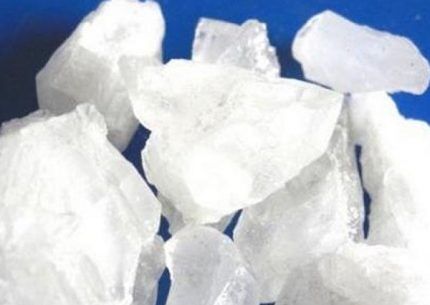
When added to the sewer, the drug effectively dilutes waste, while simultaneously neutralizing unpleasant odors. After the effect of the drug ends, the processed contents of the cesspool can be quickly pumped out and disposed of.
Another useful property of nitrate cleaners is that their effectiveness does not decrease upon contact with even the most aggressive household chemicals.Products of this type are suitable for cleaning not only the pit, but also the entire sewer system.
There is currently no accurate data on how safe drugs based on ammonium salts are. Therefore, when using this product, like any aggressive chemical, you need to carefully study the instructions and follow them exactly.
The presence of chlorine-containing agents in wastewater may weaken the effect of using this drug, but according to reviews, it copes well with unpleasant odors.
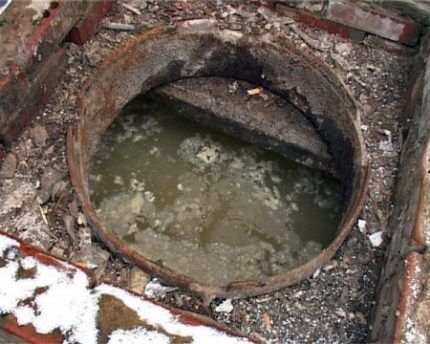
When choosing a sewer cleaning method, you should take into account your specific situation. For example, if you need to clean a cesspool under a separate toilet, you should pay attention to products that can dissolve not only drains, but also toilet paper.
Solving the siltation problem
Siltation is a serious problem for permeable filter well, and for a sealed cesspool. In the first case, the liquid part of the sediment will not be able to enter the ground due to the dense silt layer that covers the internal walls of the structure. In the second case, sewage will have to be pumped out more often, since deposits will reduce the volume of the container.
One of the signs that sludge is forming inside a cesspool is the appearance of a characteristic unpleasant odor - hydrogen sulfide vapor. When figuring out how to clean a silted cesspool, you must remember that in this case you need to do more than just neutralize the waste or pump out the contents.
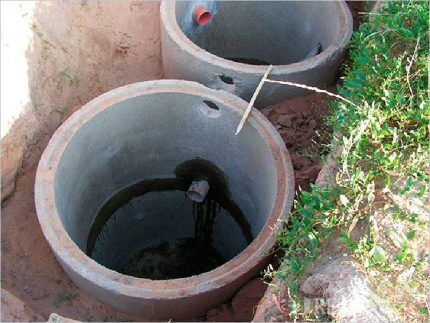
All plaque should be removed from the walls and bottom of the container. To do this, chemicals or chemical cleaning methods are used, but a combination of these methods is often most effective. During mechanical cleaning, the bulk of the sewage is first pumped out. After this, you need to supply water under strong pressure using a hose into the container.
The inner surface of the cesspool is treated with a jet in such a way as to break up the silty sediment and dismember it into individual small particles. Processing is carried out until the container is filled by approximately 25%. After this the contents pumped out with a pump or a sludge sucker and then disposed of.
To chemically clean a silted structure, chemical cleaners are used that are designed to dissolve solid inclusions—the nitrate oxidizers already described above. They usually also cope with silty deposits.After some time, all or almost all of the contents will become liquid and can be pumped out without problems.
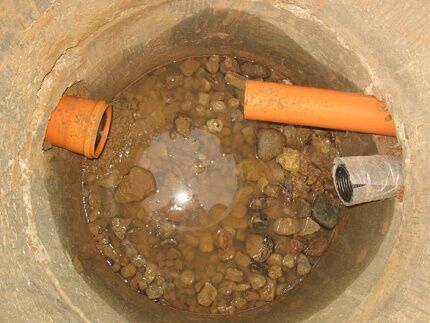
It is worth noting that the use of chemicals will be much more expensive than emptying by pumping, but this operation is easier to perform and will take less time. In the process of physically removing sludge, you will have to put up with a large amount of dirt, which is usually accompanied by this procedure.
In cesspools without a bottom, you will also have to clean or update the sand and gravel filter located at the bottom. The safest thing to do would be to remove the entire contents of the filter and re-install the clean components: a layer of sand, crushed stone and/or gravel about 40 centimeters thick.
To prevent siltation of the cesspool, it is recommended to drain water from it to a filtration field. It is best to do this at the stage of creating the structure, but if desired, you can perform this operation later. To do this, you need to install a horizontal sewer pipe for disposal of liquid waste.
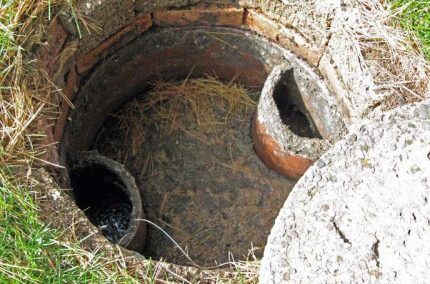
To install a filtration field, you need to excavate the soil to the level of laying the outlet pipe. A layer of agrofibre is laid down, and crushed stone is poured on top. A pipe coming out of the cesspool is laid on this “cushion”. The pipe must be perforated; you just need to make holes in it at equal distances.
Another layer of crushed stone is poured on top of the pipe, and then covered again with agrofibre. It turns out that the pipe is surrounded on all sides by filter materials. This will ensure rapid removal of liquid contents from the cesspool and its safe disposal in the soil.
Some valuable recommendations
If problems with the cesspool begin to occur more often, it makes sense to improve the operation of the structure in accessible ways. Some are satisfied cesspool with overflow, which functions like a septic tank. To do this, next to the existing container, they arrange another one, approximately the same.
The first container should be airtight, and the second should be permeable or without a bottom. It is possible to make the second container airtight, but then provision should be made for the juices to be discharged to a filtration field or to a drainage well. The overflow between these two sections is installed with a slight slope in the upper third of the containers.
First, the wastewater will flow into the first compartment, where it will settle, solid waste will sink to the bottom, and the liquid component of the sewer content will overflow when it reaches the desired level.
The second compartment will receive mainly liquid waste, which will quickly move to the filtration field for further disposal. As a result, the pit will have to be cleaned much less frequently, and the likelihood of siltation of the structure will noticeably decrease.
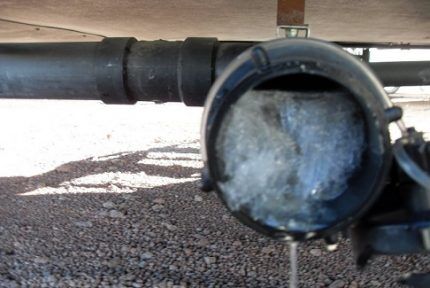
In winter, the drainage in the cesspool may freeze, which will lead to problems in the operation of the sewerage system. To correct the situation, the frozen mass must be thawed.Traditionally this is done using heat gun or its homemade analogue. If there is no power supply, fires are lit next to the frozen pit, a blowtorch is used, etc.
For craftsmen who have at least a little experience working with electricians, another method of defrosting a cesspool is available - heating directly using electric current. A metal pin is driven into the middle of the frozen cesspool to approximately the freezing depth.
Then you need to take an electrical cable of a suitable length. Its end is stripped and connected to the pin, and 220V power is supplied to the opposite end.
It may take quite a lot of time to completely defrost the structure, sometimes you need to wait about a day, it all depends on the size of the pit. When performing this type of work, it is imperative to comply with electrical safety requirements, for example, use protective rubber gloves, shoes, etc.
If it is not the pit that freezes, but the sewer pipe leading to it, this indicates flaws in the laying of communications, for example, the trench was not deep enough or there is no insulation. These problems can be corrected in the summer, but during cold weather, care should be taken to defrost the pipes.
Electric current can also be used for this. At the end of the cable you need to strip a section equal to the circumference of the pipe. To calculate this value, you simply need to multiply the pipe diameter by 3.14, i.e. to the number “pi”.
The protected wire is then wound around the frozen pipe. Power is supplied to the cable; after a couple of hours of such heating, the contents of the pipe will melt and the operation of the sewer system will resume.
Conclusions and useful video on the topic
A practical option for cleaning a silted cesspool is presented in this video:
Here we demonstrate the procedure for pumping waste out of a cesspool using a fecal pump, which should be washed periodically:
The process and result of using a bioactivator to clean a cesspool can be seen in this video:
Although a cesspool is a very simple option for an autonomous sewer system, it requires proper maintenance and timely cleaning. Modern means allow you to get rid of waste accumulated in a building quickly and efficiently.
Still have questions about cleaning cesspools? Or maybe you know other equally effective methods and have already tried them in practice? Ask your questions and share your experience in the block located at the bottom of the article.




The best way is to dig a new one :-)
No, but now it’s a mechanical method, in my opinion, the most affordable is 800 rubles per cubic meter of pumping, it’s easier to find 3-4 thousand rubles than to dive into such a topic yourself.
After all, cleaning is not such a frequent process for a private house, where 4-5 people go to the toilet.
In the villages over there, the pits under the toilets have been filling up for decades and the waste normally goes into the ground there.
Oh, this kind of work is not for me. I wouldn’t dive into shit, I don’t have such a suit. It’s better to pay those unfortunate people a couple of thousand than to do such dirty work. But if you don’t care about all this and just want to save money, then the flag is in your hands. Do everything as written above and it should work out. My friend was cleaning, but he had a professional suit for such an activity, and I would have climbed in that.At the very least, I'd rather dig a new waste pit.
Although there are several methods for cleaning a cesspool from sewage waste, I use the old, proven method. I call a specialized machine and use a hose to pump out the accumulated waste into a tank installed on the vacuum truck. They deliver. Of course, this is expensive, but it is effective. There is nothing you can do about the smell after pumping it out, but it will disappear.
I fully support all the commenters above. Nowadays it’s easier to call a vacuum cleaner than to climb into a cesspool yourself. In the villages they dig new ones, and in urban areas they use the services.
Interesting people you are! In this article, no one encourages anyone to climb into a cesspool. It seems like you didn’t read the article at all!